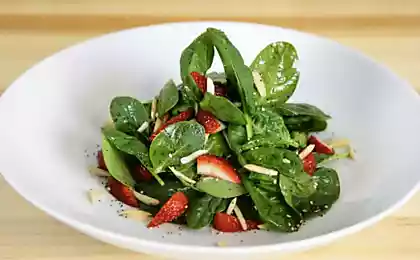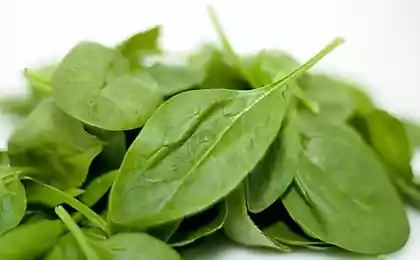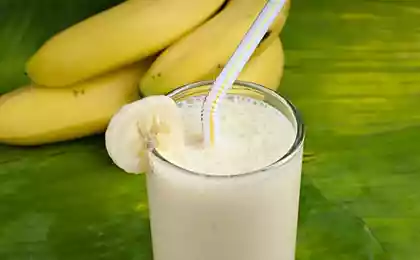565
What You need to know about spinach

Spinach is an excellent leafy vegetable, which is rich in antioxidants and has anti-cancer properties. While it contains no cholesterol. Its soft and crunchy leaves have been used in the recipes of many dishes and is used all over the world. Botany relates to the Amaranthaceae family, its scientific name is Spinacia oleracea.
The benefit of spinach for health
Spinach is a storehouse of many phytonutrients that prevent disease and enhance health.
It is very low calorie. Its energy value is only 23 kilocalories per 100 grams of fresh leaves. They contain sufficient amount of dietary fiber. Spinach is included in diets recommended to normalize cholesterol levels and reduce weight.
100 grams of fresh spinach contains about 25% of the recommended daily consumption of iron, being one of the most iron-rich green leafy vegetables.
Fresh spinach leaves are rich in several important antioxidants-vitamins a and C, and polyphenolic antioxidants, lutein, zeaxanthin and beta-carotene. All together, these compounds are scavengers of oxygen free radicals and reactive oxygen species, which play a role in the aging process and the development of various diseases.
Zeaxanthin is an important dietary carotenoid that selectively absorbed by the spot of the retina. It has antioxidant and svetodinamichesky properties. Thus, it helps to protect yourself (especially the elderly) from age-related macular degeneration.
Vitamin A is essential for maintaining the skin's mucous membranes in a healthy condition and to maintain normal vision. Eating natural vegetables and fruits rich in vitamin a and flavonoids, helps to prevent lung cancer and oral cavity.
Spinach is also rich in vitamin K. 100 g of fresh greens spinach contains 402% from recommended daily consumption of this vitamin. Vitamin K is vital because it contributes to strengthening bones, promoting osteotropic activity in them. It also plays a stabilizing role for patients with Alzheimer's disease, reducing damage to neurons in the brain damage.
The green leafy vegetables in sufficient amounts also contains B complex vitamins, B6 (pyridoxine), thiamin (vitamin B1), Riboflavin, as well as folate and Niacin. Folates help prevent the development of neural tube defects of the fetus.
100 grams of fresh spinach contain 47% of the recommended daily value of vitamin C. Vitamin C — a vital antioxidant that helps the body develop resistance against infectious agents and cleansing from harmful free radicals of oxygen.
The spinach leaves also contain sufficient amount of minerals such as potassium, magnesium, manganese, copper and zinc. Potassium is an important component fluids of the cells and organism, helps control heart rate and blood pressure. Manganese and copper used by the body as a contributing factor in the antioxidant enzyme (enzyme) called superoxide dismutase. Copper is required for the production of red blood cells. Zinc is a co-factor for many enzymes regulating development and growth, spermatogenesis, digestion and nucleic acid synthesis.
Spinach is also a good source of omega-3.
Regular consumption of spinach in the food helps to prevent osteoporosis, iron-deficiency anemia. It is believed that the leaves protect the human body from cardiovascular diseases and cancers of the colon and prostate.
How to select and store spinach?
Spinach belongs to those vegetables, which are richer in the winter sometimes. In shops and markets prefer fresh and not dull dark green leaves. Avoid yellowed leaves with spots.
Home carefully rinse the leaves under running water and then place them in salted water for about half an hour to wash away dirt and residues of insecticides.
Keep the spinach should be refrigerated for about a week. The fresher the leaves, the more nutritious qualities they give. So you should eat them as early as possible.

Spinach in cooking
Soft fresh young spinach leaves can be eaten raw in salads and veggie burgers or squeeze the juice from them. While stewing, frying or boiling antioxidant properties of spinach can be greatly reduced, especially during prolonged heat treatment.
Along with other vegetables, spinach is used in cooking pasta, pilaf, pies and soups, as well as in baby food.
In India and Pakistan popular "Palak", a dish with spinach. For example, Palak Paneer — cheese with spinach and aloo Palak — potatoes with spinach. He also used to cook fried rice, chicken and meat.
In India and Bangladesh spinach mixed with other seasonal greens, which included pigweed, fenugreek (Shambhala), mustard greens, Malabar spinach and others for a great side dish called "saag", which is served with fresh roti bread and rice.
Spinach should be careful
Re-heating (warming) the remaining spinach may cause conversion of nitrates into nitrites and nitrosamines under the influence of a certain bacteria that thrives in the prepared food, rich in nitrates, such as spinach and many other green vegetables. Nitrites and nitrosamines are harmful to health, especially for children.
Salt of phytic acid and dietary fiber in the leaves may interfere with the bioavailability of iron, calcium and magnesium.
Because spinach is rich in vitamin K, patients taking anticoagulant drugs (such as "Warfarin"), you should avoid eating spinach in food, because it interferes with the action of drugs.
Spinach contains oxalic acid, a natural substance that is found in certain vegetables. This acid is some people in the urinary tract to crystallize in oxalate stones. People who have in the urinary tract have oxalate stones, you should avoid vegetables belonging to the family Amaranthaceae and Brassica. To maintain urinary tract in normal condition it is recommended to consume water in sufficient quantity.
Spinach can also contain estrogen, which can interfere with the production of hormone by the thyroid gland and lead to deficiency of thyroxin in people with thyroid dysfunction.
Nutritional value of spinach
In parentheses are the percentage of the daily allowance. Nutritional value is based on 100 grams fresh spinach according to information from the Ministry of agriculture of the United States.
General information:
- energy value — 23 kilocalories (1%);
- carbohydrates — 3.63 grams (3%);
- protein — 2.86 grams (5%);
- fat — 0.39 grams (1,5%);
- cholesterol — 0 milligrams (0%);
- fiber, part of the food for 2.2 grams (6%).
- folate — 194 micrograms (48,5%);
- nicotinic acid — 0,724 milligrams (4,5%);
- Pantothenic acid — of 0.065 milligrams (1%);
- pyridoxine (vitamin B6) — 0,195 mg (15%);
- Riboflavin (vitamin B2) — 0,189 mg (14,5%);
- thiamine (vitamin B1) — 0.078 milligram (6,5%);
- vitamin A — 9377 international units (IU, IU) is 312%;
- vitamin C — 28.1 milligrams (47%);
- vitamin E — 2.03 milligrams (13,5%);
- vitamin K — 482 micrograms (402%).
- sodium — 79 mg (5%);
- potassium 558 mg (12%).
- calcium — 99 mg (10%);
- copper — 0,130 mg (14%);
- iron — 2.71 milligrams (34%);
- magnesium 79 mg (20%);
- manganese — 0,897 milligrams (39%);
- zinc — 0,53 mg (5%).
- beta-carotene (ß-carotene), which is rich in carrots — 5626 micrograms;
- beta-cryptoxanthin (ß-cryptoxanthin) — 0 micrograms;
- lutein-zeaxanthin 12198 micrograms.
Source: hi-news.ru
Each of these 5 products robs You of vitality
Their hands: Cellar glacier —dry freezer all year round























